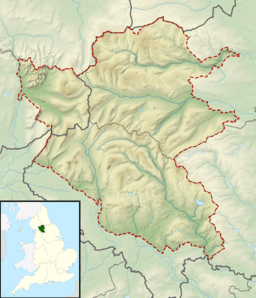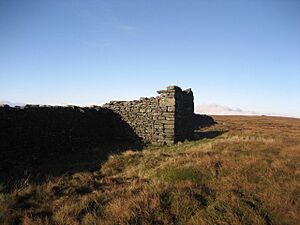Birks Fell facts for kids
Quick facts for kids Birks Fell |
|
|---|---|

Frozen Peat on Birks Fell
|
|
| Highest point | |
| Elevation | 610 m (2,000 ft) |
| Parent peak | Pen-y-ghent |
| Listing | Marilyn |
| Geography | |
| Parent range | Southern Yorkshire Dales |
| OS grid | SD918763 |
Birks Fell is a cool hill located in the beautiful Yorkshire Dales in North Yorkshire, England. It's close to a village called Hubberholme. This hill is special because it's known as a "Marilyn."
Contents
What is a Marilyn?
A Marilyn is a type of hill or mountain. To be a Marilyn, a hill must have a "topographic prominence" of at least 150 meters (about 492 feet). This means it rises at least 150 meters above the land around it. Think of it as how much a hill stands out from its surroundings.
Birks Fell officially became a Marilyn in 2006. Before that, people thought it was a bit shorter. But a new survey showed it was actually 2,001 feet tall! That's about 610 meters. This new height made it taller than a nearby hill, Horse Head Moor. So, Birks Fell took its place as a Marilyn.
Exploring Birks Fell
The top of Birks Fell is a wide, flat area. It's a great spot for walking and offers amazing views of the Yorkshire Dales. Imagine seeing green valleys and other hills stretching far away!
Birks Tarn: A Hidden Lake
About one mile southwest of the summit, you'll find Birks Tarn. A "tarn" is a small mountain lake. Birks Tarn is one of the biggest tarns in the Yorkshire Dales. It stays full of water because of the special ground underneath it. The layers of rock and peaty soil stop the water from leaking away.
A Look Back: Mining History
Long ago, people mined for lead on the eastern side of Birks Fell. This mining happened between 1699 and 1815. Lead was a very important metal back then. You can still see old ruined buildings scattered across the landscape. These were once used in the process of getting the metal out of the ground.
Where Did the Name Come From?
The name "Birks" has an interesting origin. It comes from an old language called Old Norse. In Old Norse, "birks" meant "birch." This tells us that the lower parts of the hill used to be covered in birch trees.



